【重学Java】IO流
IO流的UML类图

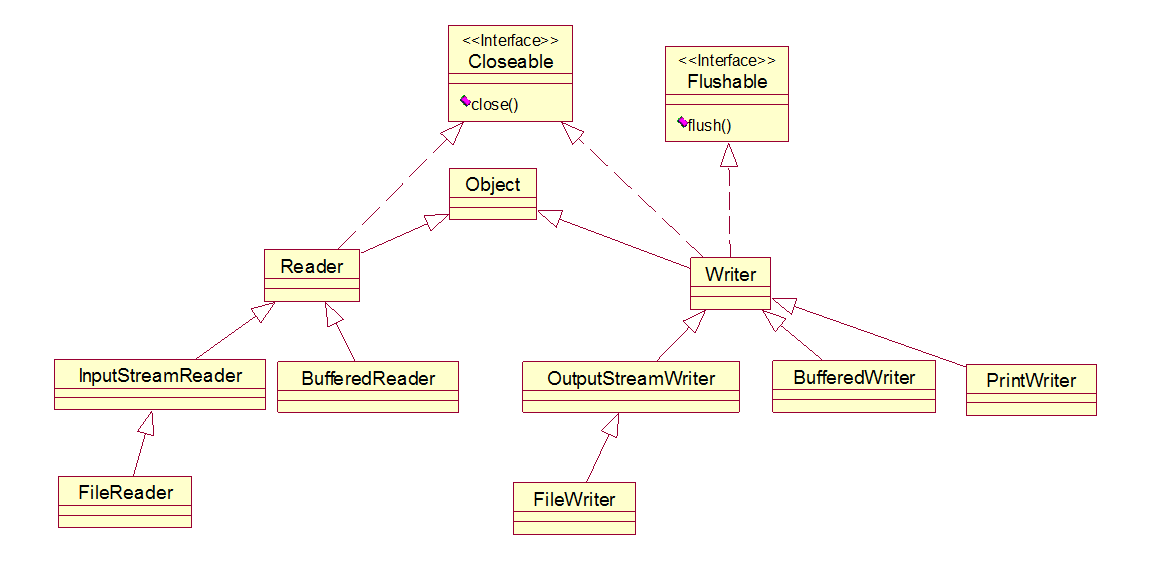
File类
File类概述和构造方法【应用】
-
File类介绍
- 它是文件和目录路径名的抽象表示
- 文件和目录是可以通过File封装成对象的
- 对于File而言,其封装的并不是一个真正存在的文件,仅仅是一个路径名而已.它可以是存在的,也可以是不存在的.将来是要通过具体的操作把这个路径的内容转换为具体存在的
-
File类的构造方法
方法名 说明 File(String pathname) 通过将给定的路径名字符串转换为抽象路径名来创建新的 File实例 File(String parent, String child) 从父路径名字符串和子路径名字符串创建新的 File实例 File(File parent, String child) 从父抽象路径名和子路径名字符串创建新的 File实例 -
示例代码
public class FileDemo01 {
public static void main(String[] args) {
//File(String pathname): 通过将给定的路径名字符串转换为抽象路径名来创建新的 File实例
File f1 = new File("E:\\itcast\\java.txt");
System.out.println(f1);
//File(String parent, String child): 从父路径名字符串和子路径名字符串创建新的 File实例
File f2 = new File("E:\\itcast","java.txt");
System.out.println(f2);
//File(File parent, String child): 从父抽象路径名和子路径名字符串创建新的 File实例
File f3 = new File("E:\\itcast");
File f4 = new File(f3,"java.txt");
System.out.println(f4);
}
}
绝对路径和相对路径【理解】
-
绝对路径
是一个完整的路径,从盘符开始
-
相对路径
是一个简化的路径,相对当前项目下的路径
-
示例代码
public class FileDemo02 {
public static void main(String[] args) {
// 是一个完整的路径,从盘符开始
File file1 = new File("D:\\itcast\\a.txt");
// 是一个简化的路径,从当前项目根目录开始
File file2 = new File("a.txt");
File file3 = new File("模块名\\a.txt");
}
}
File类创建功能【应用】
-
方法分类
方法名 说明 public boolean createNewFile() 当具有该名称的文件不存在时,创建一个由该抽象路径名命名的新空文件。若存在该名称的文件则返回false。
不管调用者有没有后缀名,只能创建文件public boolean mkdir() 创建由此抽象路径名命名的目录
只能重建单级文件夹,不能创建多级文件夹
不管有没有后缀名,只能创建单级文件夹(一般不用该方法,mkdirs可以代替)public boolean mkdirs() 创建由此抽象路径名命名的目录,包括任何必需但不存在的父目录
创建一个多级文件夹 也可以创建一个单级文件夹 -
示例代码
public class FileDemo02 {
public static void main(String[] args) throws IOException {
//需求1:我要在E:\\itcast目录下创建一个文件java.txt
File f1 = new File("E:\\itcast\\java.txt");
System.out.println(f1.createNewFile());
System.out.println("--------");
//需求2:我要在E:\\itcast目录下创建一个目录JavaSE
File f2 = new File("E:\\itcast\\JavaSE");
System.out.println(f2.mkdir());
System.out.println("--------");
//需求3:我要在E:\\itcast目录下创建一个多级目录JavaWEB\\HTML
File f3 = new File("E:\\itcast\\JavaWEB\\HTML");
// System.out.println(f3.mkdir());
System.out.println(f3.mkdirs());
System.out.println("--------");
//需求4:我要在E:\\itcast目录下创建一个文件javase.txt
File f4 = new File("E:\\itcast\\javase.txt");
// System.out.println(f4.mkdir());
System.out.println(f4.createNewFile());
}
}
File类删除功能【应用】
-
方法分类
方法名 说明 public boolean delete() 删除由此抽象路径名表示的文件或目录,删除的文件不进入回收站
如果删除的是文件,那么直接删除;如果删除的是文件夹,那么只能删除空文件夹
如果要删除一个有内容的文件夹,只能先进入该文件夹中,把里面的内容删除完毕才能再次删除这个文件夹
简单来说:只能删除文件和空文件夹 -
示例代码
public class FileDemo03 {
public static void main(String[] args) throws IOException {
// File f1 = new File("E:\\itcast\\java.txt");
//需求1:在当前模块目录下创建java.txt文件
File f1 = new File("myFile\\java.txt");
// System.out.println(f1.createNewFile());
//需求2:删除当前模块目录下的java.txt文件
System.out.println(f1.delete());
System.out.println("--------");
//需求3:在当前模块目录下创建itcast目录
File f2 = new File("myFile\\itcast");
// System.out.println(f2.mkdir());
//需求4:删除当前模块目录下的itcast目录
System.out.println(f2.delete());
System.out.println("--------");
//需求5:在当前模块下创建一个目录itcast,然后在该目录下创建一个文件java.txt
File f3 = new File("myFile\\itcast");
// System.out.println(f3.mkdir());
File f4 = new File("myFile\\itcast\\java.txt");
// System.out.println(f4.createNewFile());
//需求6:删除当前模块下的目录itcast
System.out.println(f4.delete());
System.out.println(f3.delete());
}
}
File类判断和获取功能【应用】
-
判断功能
方法名 说明 public boolean isDirectory() 测试此抽象路径名表示的File是否为目录 public boolean isFile() 测试此抽象路径名表示的File是否为文件 public boolean exists() 测试此抽象路径名表示的File是否存在 -
获取功能
方法名 说明 public String getAbsolutePath() 返回此抽象路径名的绝对路径名字符串 public String getPath() 将此抽象路径名转换为路径名字符串 public String getName() 返回由此抽象路径名表示的文件或目录的名称
如果调用者是文件,那么获取的是文件名和后缀名
如果调用者是一个文件夹,那么获取的是文件夹的名字public File[] listFiles() 返回此抽象路径名表示的目录中的文件和目录的File对象数组(包括隐藏文件和隐藏文件夹) 
-
示例代码
public class FileDemo04 {
public static void main(String[] args) {
//创建一个File对象
File f = new File("myFile\\java.txt");
// public boolean isDirectory():测试此抽象路径名表示的File是否为目录
// public boolean isFile():测试此抽象路径名表示的File是否为文件
// public boolean exists():测试此抽象路径名表示的File是否存在
System.out.println(f.isDirectory());
System.out.println(f.isFile());
System.out.println(f.exists());
// public String getAbsolutePath():返回此抽象路径名的绝对路径名字符串
// public String getPath():将此抽象路径名转换为路径名字符串
// public String getName():返回由此抽象路径名表示的文件或目录的名称
System.out.println(f.getAbsolutePath());
System.out.println(f.getPath());
System.out.println(f.getName());
System.out.println("--------");
// public File[] listFiles():返回此抽象路径名表示的目录中的文件和目录的File对象数组
File f2 = new File("E:\\itcast");
File[] fileArray = f2.listFiles();
for(File file : fileArray) {
// System.out.println(file);
// System.out.println(file.getName());
if(file.isFile()) {
System.out.println(file.getName());
}
}
}
}
File类练习一【应用】
-
案例需求
在当前模块下的aaa文件夹中创建一个a.txt文件
-
实现步骤
- 创建File对象,指向aaa文件夹
- 判断aaa文件夹是否存在,如果不存在则创建
- 创建File对象,指向aaa文件夹下的a.txt文件
- 创建这个文件
-
代码实现
public class Test1 {
public static void main(String[] args) throws IOException {
//练习一:在当前模块下的aaa文件夹中创建一个a.txt文件
/* File file = new File("filemodule\\aaa\\a.txt");
file.createNewFile();*/
//注意点:文件所在的文件夹必须要存在.
//1.创建File对象,指向aaa文件夹
File file = new File("filemodule\\aaa");
//2.判断aaa文件夹是否存在,如果不存在则创建
if(!file.exists()){
//如果文件夹不存在,就创建出来
file.mkdirs();
}
//3.创建File对象,指向aaa文件夹下的a.txt文件
File newFile = new File(file,"a.txt");
//4.创建这个文件
newFile.createNewFile();
}
}
File类练习二【应用】
-
案例需求
删除一个多级文件夹
-
实现步骤
- 定义一个方法,接收一个File对象
- 遍历这个File对象,获取它下边的每个文件和文件夹对象
- 判断当前遍历到的File对象是文件还是文件夹
- 如果是文件,直接删除
- 如果是文件夹,递归调用自己,将当前遍历到的File对象当做参数传递
- 参数传递过来的文件夹File对象已经处理完成,最后直接删除这个空文件夹
-
代码实现
public class Test2 {
public static void main(String[] args) {
//练习二:删除一个多级文件夹
//delete方法
//只能删除文件和空文件夹.
//如果现在要删除一个有内容的文件夹?
//先删掉这个文件夹里面所有的内容.
//最后再删除这个文件夹
File src = new File("C:\\Users\\apple\\Desktop\\src");
deleteDir(src);
}
//1.定义一个方法,接收一个File对象
private static void deleteDir(File src) {
//先删掉这个文件夹里面所有的内容.
//递归 方法在方法体中自己调用自己.
//注意: 可以解决所有文件夹和递归相结合的题目
//2.遍历这个File对象,获取它下边的每个文件和文件夹对象
File[] files = src.listFiles();
//3.判断当前遍历到的File对象是文件还是文件夹
for (File file : files) {
//4.如果是文件,直接删除
if(file.isFile()){
file.delete();
}else{
//5.如果是文件夹,递归调用自己,将当前遍历到的File对象当做参数传递
deleteDir(file);//参数一定要是src文件夹里面的文件夹File对象
}
}
//6.参数传递过来的文件夹File对象已经处理完成,最后直接删除这个空文件夹
src.delete(); //这一步必须放在函数里参与递归,把每一个空文件夹删除
}
}
File类练习三【应用】
-
案例需求
统计一个文件夹中每种文件的个数并打印
打印格式如下:
txt:3个 doc:4个 jpg:6个 … -
实现步骤
- 定义一个方法,参数是HashMap集合用来统计次数和File对象要统计的文件夹
- 遍历File对象,获取它下边的每一个文件和文件夹对象
- 判断当前File对象是文件还是文件夹
- 如果是文件,判断这种类型文件后缀名在HashMap集合中是否出现过
- 没出现过,将这种类型文件的后缀名存入集合中,次数存1
- 出现过,获取这种类型文件的后缀名出现的次数,对其+1,在存回集合中
- 如果是文件夹,递归调用自己,HashMap集合就是参数集合,File对象是当前文件夹对象
-
代码实现
public class Test3 {
public static void main(String[] args) {
//统计一个文件夹中,每种文件出现的次数.
//统计 --- 定义一个变量用来统计. ---- 弊端:同时只能统计一种文件
//利用map集合进行数据统计,键 --- 文件后缀名 值 ---- 次数
File file = new File("filemodule");
HashMap<String, Integer> hm = new HashMap<>();
getCount(hm, file);
System.out.println(hm);
}
//1.定义一个方法,参数是HashMap集合用来统计次数和File对象要统计的文件夹
private static void getCount(HashMap<String, Integer> hm, File file) {
//2.遍历File对象,获取它下边的每一个文件和文件夹对象
File[] files = file.listFiles();
for (File f : files) {
//3.判断当前File对象是文件还是文件夹
if(f.isFile()){
//如果是文件,判断这种类型文件后缀名在HashMap集合中是否出现过
String fileName = f.getName();
String[] fileNameArr = fileName.split("\\.");
if(fileNameArr.length == 2){
String fileEndName = fileNameArr[1];
if(hm.containsKey(fileEndName)){
//出现过,获取这种类型文件的后缀名出现的次数,对其+1,在存回集合中
Integer count = hm.get(fileEndName);
//这种文件又出现了一次.
count++;
//把已经出现的次数给覆盖掉.
hm.put(fileEndName,count);
}else{
// 没出现过,将这种类型文件的后缀名存入集合中,次数存1
hm.put(fileEndName,1);
}
}
}else{
//如果是文件夹,递归调用自己,HashMap集合就是参数集合,File对象是当前文件夹对象代码实现
getCount(hm,f);
}
}
}
}
字节流
IO流概述和分类【理解】
- IO流介绍
- IO:输入/输出(Input/Output)
- 流:是一种抽象概念,是对数据传输的总称.也就是说数据在设备间的传输称为流,流的本质是数据传输
- IO流就是用来处理设备间数据传输问题的.常见的应用: 文件复制; 文件上传; 文件下载
- IO流的分类
- 按照数据的流向
- 输入流:读数据
- 输出流:写数据
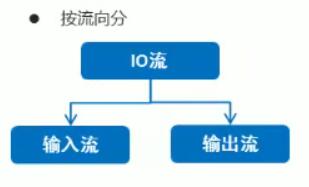
- 按照数据类型来分
- 字节流
- 字节输入流
- 字节输出流
- 字符流
- 字符输入流
- 字符输出流
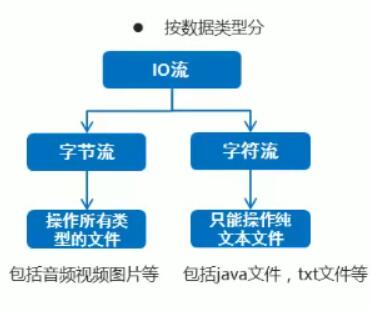
- 字节流
- 按照数据的流向
- IO流的使用场景
- 如果操作的是纯文本文件,优先使用字符流
- 如果操作的是图片、视频、音频等二进制文件,优先使用字节流
- 如果不确定文件类型,优先使用字节流.字节流是万能的流
- close和flush注意事项
-
所有的流都实现了:java.io.Closeable接口,都是可关闭的,都有close()方法。流毕竟是一个管道,这个是内存和硬盘之间的通道,用完之后一定要关闭,不然会耗费(占用)很多资源。养成好习惯,用完流一定要关闭。
-
所有的输出流都实现了:java.io.Flushable接口,都是可刷新的,都有flush()方法。养成一个好习惯,输出流在最终输出之后,一定要记得flush()刷新一下。这个刷新表示将通道/管道当中剩余未输出的数据强行输出完(清空管道!)刷新的作用就是清空管道。
注意:如果没有flush()可能会导致丢失数据。
-
字节流写数据【应用】
-
字节流抽象基类
- InputStream:这个抽象类是表示字节输入流的所有类的超类
- OutputStream:这个抽象类是表示字节输出流的所有类的超类
- 子类名特点:子类名称都是以其父类名作为子类名的后缀
-
字节输出流
- FileOutputStream(String name):创建文件输出流以指定的名称写入文件
-
使用字节输出流写数据的步骤
- 创建字节输出流对象(调用系统功能创建了文件,创建字节输出流对象,让字节输出流对象指向文件)
- 调用字节输出流对象的写数据方法
- 释放资源(关闭此文件输出流并释放与此流相关联的任何系统资源)
-
示例代码
public class FileOutputStreamDemo01 {
public static void main(String[] args) throws IOException {
//创建字节输出流对象
/*
注意点:
1.如果文件不存在,会帮我们创建
2.如果文件存在,会把文件清空
*/
//FileOutputStream(String name):创建文件输出流以指定的名称写入文件
FileOutputStream fos = new FileOutputStream("myByteStream\\fos.txt");
//void write(int b):将指定的字节写入此文件输出流
fos.write(97);
// fos.write(57);
// fos.write(55);
//最后都要释放资源
//void close():关闭此文件输出流并释放与此流相关联的任何系统资源。
fos.close();
}
}
字节流写数据的三种方式【应用】
-
写数据的方法分类
方法名 说明 void write(int b) 将指定的字节写入此文件输出流 一次写一个字节数据 void write(byte[] b) 将 b.length字节从指定的字节数组写入此文件输出流 一次写一个字节数组数据 void write(byte[] b, int off, int len) 将 len字节从指定的字节数组开始,从偏移量off开始写入此文件输出流 一次写一个字节数组的部分数据 -
示例代码
public class FileOutputStreamDemo02 {
public static void main(String[] args) throws IOException {
//FileOutputStream(String name):创建文件输出流以指定的名称写入文件
FileOutputStream fos = new FileOutputStream("myByteStream\\fos.txt");
//FileOutputStream(File file):创建文件输出流以写入由指定的 File对象表示的文件
// FileOutputStream fos = new FileOutputStream(new File("myByteStream\\fos.txt"));
//void write(int b):将指定的字节写入此文件输出流
// fos.write(97);
// fos.write(98);
// fos.write(99);
// fos.write(100);
// fos.write(101);
// void write(byte[] b):将 b.length字节从指定的字节数组写入此文件输出流
// byte[] bys = {97, 98, 99, 100, 101};
//byte[] getBytes():返回字符串对应的字节数组
byte[] bys = "abcde".getBytes();
// fos.write(bys);
//void write(byte[] b, int off, int len):将 len字节从指定的字节数组开始,从偏移量off开始写入此文件输出流
// fos.write(bys,0,bys.length);
fos.write(bys,1,3);
//释放资源
fos.close();
}
}
字节流写数据的两个小问题【应用】
-
字节流写数据如何实现换行
windows:\r\nlinux:\nmac:\r
-
字节流写数据如何实现追加写入
public FileOutputStream(String name,boolean append)- 创建文件输出流以指定的名称写入文件。如果第二个参数为true ,则字节将写入文件的末尾而不是开头
-
示例代码
public class FileOutputStreamDemo03 {
public static void main(String[] args) throws IOException {
//创建字节输出流对象
// FileOutputStream fos = new FileOutputStream("myByteStream\\fos.txt");
FileOutputStream fos = new FileOutputStream("myByteStream\\fos.txt",true);
//写数据
for (int i = 0; i < 10; i++) {
fos.write("hello".getBytes());
fos.write("\r\n".getBytes());
}
//释放资源
fos.close();
}
}
字节流写数据加异常处理【应用】
-
异常处理格式
- try-catch-finally
try{
可能出现异常的代码;
}catch(异常类名 变量名){
异常的处理代码;
}finally{
执行所有清除操作;
}
-
finally特点
- 被finally控制的语句一定会执行,除非JVM退出
-
示例代码
public class FileOutputStreamDemo04 {
public static void main(String[] args) {
//加入finally来实现释放资源
FileOutputStream fos = null;
try {
fos = new FileOutputStream("myByteStream\\fos.txt");
fos.write("hello".getBytes());
} catch (IOException e) {
e.printStackTrace();
} finally {
if(fos != null) {
try {
fos.close();
} catch (IOException e) {
e.printStackTrace();
}
}
}
}
}
字节流读数据(一次读一个字节数据)【应用】
-
字节输入流
- FileInputStream(String name):通过打开与实际文件的连接来创建一个FileInputStream,该文件由文件系统中的路径名name命名
-
字节输入流读取数据的步骤
- 创建字节输入流对象
- 调用字节输入流对象的读数据方法
- 释放资源
-
示例代码
public class FileInputStreamDemo01 {
public static void main(String[] args) throws IOException {
//创建字节输入流对象
//FileInputStream(String name)
FileInputStream fis = new FileInputStream("myByteStream\\fos.txt");
int by;
/*
fis.read():读数据
by=fis.read():把读取到的数据赋值给by
by != -1:判断读取到的数据是否是-1
*/
while ((by=fis.read())!=-1) {
System.out.print((char)by);
}
//释放资源
fis.close();
}
}
字节流复制文件【应用】
-
案例需求
把“E:\itcast\窗里窗外.txt”复制到模块目录下的“窗里窗外.txt” (文件可以是任意文件)
-
实现步骤
-
复制文本文件,其实就把文本文件的内容从一个文件中读取出来(数据源),然后写入到另一个文件中(目的地)
-
数据源:
E:\itcast\窗里窗外.txt --- 读数据 --- InputStream --- FileInputStream
-
目的地:
myByteStream\窗里窗外.txt --- 写数据 --- OutputStream --- FileOutputStream
-
-
代码实现
public class CopyTxtDemo {
public static void main(String[] args) throws IOException {
//根据数据源创建字节输入流对象
FileInputStream fis = new FileInputStream("E:\\itcast\\窗里窗外.txt");
//根据目的地创建字节输出流对象
FileOutputStream fos = new FileOutputStream("myByteStream\\窗里窗外.txt");
//读写数据,复制文本文件(一次读取一个字节,一次写入一个字节)
int by;
while ((by=fis.read())!=-1) { //(by=fis.read())小括号别忘了
fos.write(by);
}
//释放资源
fos.close();
fis.close();
}
}
字节流读数据(一次读一个字节数组数据)【应用】
-
一次读一个字节数组的方法
public int read(byte[] b):从输入流读取最多b.length个字节的数据- 返回的是读入缓冲区的总字节数,也就是实际的读取字节个数
-
示例代码
public class FileInputStreamDemo02 {
public static void main(String[] args) throws IOException {
//创建字节输入流对象
FileInputStream fis = new FileInputStream("myByteStream\\fos.txt");
byte[] bys = new byte[1024]; //1024及其整数倍
int len; //len表示一次读取到的有效字节数量
//循环读取
while ((len=fis.read(bys))!=-1) {
System.out.print(new String(bys,0,len));
}
//释放资源
fis.close();
}
}
字节流复制文件【应用】
-
案例需求
把“E:\itcast\mn.jpg”复制到模块目录下的“mn.jpg” (文件可以是任意文件去)
-
实现步骤
- 根据数据源创建字节输入流对象
- 根据目的地创建字节输出流对象
- 读写数据,复制图片(一次读取一个字节数组,一次写入一个字节数组)
- 释放资源
-
代码实现
public class CopyJpgDemo {
public static void main(String[] args) throws IOException {
//根据数据源创建字节输入流对象
FileInputStream fis = new FileInputStream("E:\\itcast\\mn.jpg");
//根据目的地创建字节输出流对象
FileOutputStream fos = new FileOutputStream("myByteStream\\mn.jpg");
//读写数据,复制图片(一次读取一个字节数组,一次写入一个字节数组)
byte[] bys = new byte[1024];
int len;
while ((len=fis.read(bys))!=-1) {
fos.write(bys,0,len);
}
//释放资源
fos.close();
fis.close();
}
}
字节缓冲流
字节缓冲流构造方法【应用】
-
字节缓冲流介绍
- BufferOutputStream:该类实现缓冲输出流.通过设置这样的输出流,应用程序可以向底层输出流写入字节,而不必为写入的每个字节导致底层系统的调用
- BufferedInputStream:创建BufferedInputStream将创建一个内部缓冲区数组.当从流中读取或跳过字节时,内部缓冲区将根据需要从所包含的输入流中重新填充,一次很多字节
-
构造方法:
方法名 说明 BufferedOutputStream(OutputStream out) 创建字节缓冲输出流对象 BufferedInputStream(InputStream in) 创建字节缓冲输入流对象 -
底层原理
-
一次读取一个字节
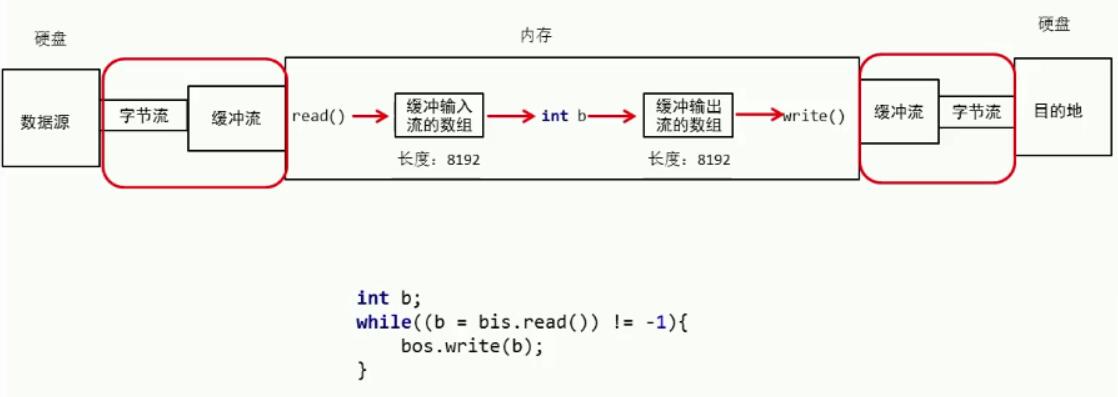
-
一次读取一个字节数组

-
创建了一个大小为8192字节的缓冲数组,减少了硬盘与内存之间数据传递的次数,提高效率。
-
-
示例代码
public class BufferStreamDemo {
public static void main(String[] args) throws IOException {
//字节缓冲输出流:BufferedOutputStream(OutputStream out)
//缓冲流也叫包装流(处理流),FileOutputStream叫节点流
BufferedOutputStream bos = new BufferedOutputStream(new FileOutputStream("myByteStream\\bos.txt"));
//写数据
bos.write("hello\r\n".getBytes());
bos.write("world\r\n".getBytes());
//释放资源
bos.close();
//字节缓冲输入流:BufferedInputStream(InputStream in)
BufferedInputStream bis = new BufferedInputStream(new FileInputStream("myByteStream\\bos.txt"));
//一次读取一个字节数据
// int by;
// while ((by=bis.read())!=-1) {
// System.out.print((char)by);
// }
//一次读取一个字节数组数据
byte[] bys = new byte[1024];
int len;
while ((len=bis.read(bys))!=-1) {
System.out.print(new String(bys,0,len));
}
//释放资源
bis.close(); //包装流关闭,节点流自动关闭
/* 源码如下
public void close() throws IOException {
byte[] buffer;
while ( (buffer = buf) != null) {
if (U.compareAndSetReference(this, BUF_OFFSET, buffer, null)) {
InputStream input = in;
in = null;
if (input != null) //关闭节点流
input.close();
return;
}
// Else retry in case a new buf was CASed in fill()
}
}*/
}
}
字节缓冲流复制视频【应用】
-
案例需求
把“E:\itcast\字节流复制图片.avi”复制到模块目录下的“字节流复制图片.avi”
-
实现步骤
- 根据数据源创建字节输入流对象
- 根据目的地创建字节输出流对象
- 读写数据,复制视频
- 释放资源
-
代码实现
public class CopyAviDemo {
public static void main(String[] args) throws IOException {
//复制视频
// method1();
method2();
}
//字节缓冲流一次读写一个字节数组
public static void method2() throws IOException {
BufferedInputStream bis = new BufferedInputStream(new FileInputStream("E:\\itcast\\字节流复制图片.avi"));
BufferedOutputStream bos = new BufferedOutputStream(new FileOutputStream("myByteStream\\字节流复制图片.avi"));
byte[] bys = new byte[1024];
int len;
while ((len=bis.read(bys))!=-1) {
bos.write(bys,0,len);
}
bos.close();
bis.close();
}
//字节缓冲流一次读写一个字节
public static void method1() throws IOException {
BufferedInputStream bis = new BufferedInputStream(new FileInputStream("E:\\itcast\\字节流复制图片.avi"));
BufferedOutputStream bos = new BufferedOutputStream(new FileOutputStream("myByteStream\\字节流复制图片.avi"));
int by;
while ((by=bis.read())!=-1) {
bos.write(by);
}
bos.close();
bis.close();
}
}
字符流
为什么会出现字符流【理解】
-
字符流的介绍
由于字节流操作中文不是特别的方便,所以Java就提供字符流
字符流 = 字节流 + 编码表
-
中文的字节存储方式
用字节流复制文本文件时,文本文件也会有中文,但是没有问题,原因是最终底层操作会自动进行字节拼接成中文,如何识别是中文的呢?
汉字在存储的时候,无论选择哪种编码存储,第一个字节都是负数

编码表【理解】
-
什么是字符集
是一个系统支持的所有字符的集合,包括各国家文字、标点符号、图形符号、数字等
l计算机要准确的存储和识别各种字符集符号,就需要进行字符编码,一套字符集必然至少有一套字符编码。常见字符集有ASCII字符集、GBXXX字符集、Unicode字符集等
-
常见的字符集
-
ASCII字符集:
lASCII:是基于拉丁字母的一套电脑编码系统,用于显示现代英语,主要包括控制字符(回车键、退格、换行键等)和可显示字符(英文大小写字符、阿拉伯数字和西文符号)
基本的ASCII字符集,使用7位表示一个字符,共128字符。ASCII的扩展字符集使用8位表示一个字符,共256字符,方便支持欧洲常用字符。是一个系统支持的所有字符的集合,包括各国家文字、标点符号、图形符号、数字等
-
GBXXX字符集:
GBK:最常用的中文码表。是在GB2312标准基础上的扩展规范,使用了双字节编码方案,共收录了21003个汉字,完全兼容GB2312标准,同时支持繁体汉字以及日韩汉字等.
注意GBK编码以后一个中文以两个字节的形式存储。
Windows默认使用GBK -
Unicode字符集:
UTF-8编码:可以用来表示Unicode标准中任意字符,它是电子邮件、网页及其他存储或传送文字的应用 中,优先采用的编码。互联网工程工作小组(IETF)要求所有互联网协议都必须支持UTF-8编码。它使用一至四个字节为每个字符编码。注意UTF-8编码以后一个中文以三个字节的形式存储
编码规则:
128个US-ASCII字符,只需一个字节编码
拉丁文等字符,需要二个字节编码
大部分常用字(含中文),使用三个字节编码
其他极少使用的Unicode辅助字符,使用四字节编码
-
字符串中的编码解码问题【应用】
-
相关方法
方法名 说明 byte[] getBytes() 使用平台的默认字符集将该 String编码为一系列字节 byte[] getBytes(String charsetName) 使用指定的字符集将该 String编码为一系列字节 String(byte[] bytes) 使用平台的默认字符集解码指定的字节数组来创建字符串 String(byte[] bytes, String charsetName) 通过指定的字符集解码指定的字节数组来创建字符串 -
代码演示
public class StringDemo {
public static void main(String[] args) throws UnsupportedEncodingException {
//定义一个字符串
String s = "中国";
//byte[] bys = s.getBytes(); //[-28, -72, -83, -27, -101, -67]
//byte[] bys = s.getBytes("UTF-8"); //[-28, -72, -83, -27, -101, -67]
byte[] bys = s.getBytes("GBK"); //[-42, -48, -71, -6]
System.out.println(Arrays.toString(bys));
//String ss = new String(bys);
//String ss = new String(bys,"UTF-8");
String ss = new String(bys,"GBK");
System.out.println(ss);
}
}
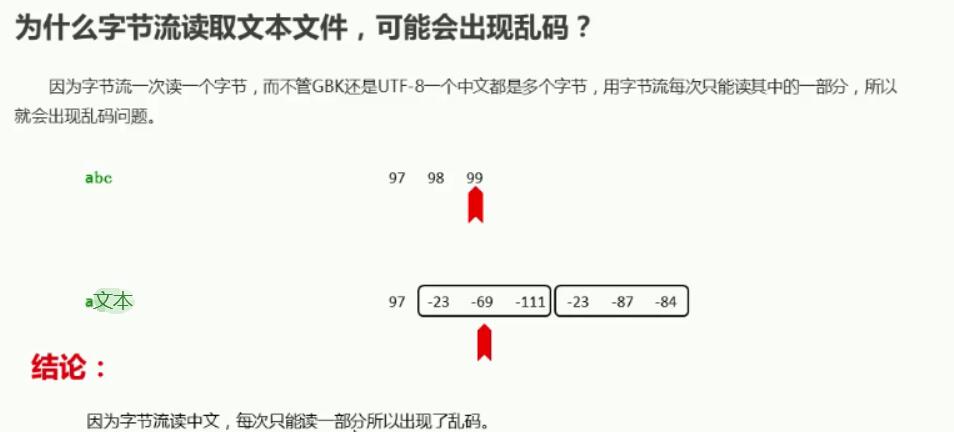
字符流写数据【应用】
-
介绍
Writer: 用于写入字符流的抽象父类
FileWriter: 用于写入字符流的常用子类
-
构造方法
方法名 说明 FileWriter(File file) 根据给定的 File 对象构造一个 FileWriter 对象 FileWriter(File file, boolean append) 根据给定的 File 对象构造一个 FileWriter 对象 FileWriter(String fileName) 根据给定的文件名构造一个 FileWriter 对象 FileWriter(String fileName, boolean append) 根据给定的文件名以及指示是否附加写入数据的 boolean 值来构造 FileWriter 对象 -
成员方法
方法名 说明 void write(int c) 写一个字符 void write(char[] cbuf) 写入一个字符数组 void write(char[] cbuf, int off, int len) 写入字符数组的一部分 void write(String str) 写一个字符串 void write(String str, int off, int len) 写一个字符串的一部分 -
刷新和关闭的方法
方法名 说明 flush() 刷新流,之后还可以继续写数据 close() 关闭流,释放资源,但是在关闭之前会先刷新流。一旦关闭,就不能再写数据 -
注意事项
-
代码演示
public class OutputStreamWriterDemo {
public static void main(String[] args) throws IOException {
//创建字符输出流对象
FileWriter fw = new FileWriter("myCharStream\\a.txt");
//void write(int c):写一个字符
// fw.write(97);
// fw.write(98);
// fw.write(99);
//void writ(char[] cbuf):写入一个字符数组
char[] chs = {'a', 'b', 'c', 'd', 'e'};
// fw.write(chs);
//void write(char[] cbuf, int off, int len):写入字符数组的一部分
// fw.write(chs, 0, chs.length);
// fw.write(chs, 1, 3);
//void write(String str):写一个字符串
// fw.write("abcde");
//void write(String str, int off, int len):写一个字符串的一部分
// fw.write("abcde", 0, "abcde".length());
fw.write("abcde", 1, 3);
//释放资源
fw.close();
}
}
字符流读数据【应用】
-
介绍
Reader: 用于读取字符流的抽象父类
FileReader: 用于读取字符流的常用子类
-
构造方法
方法名 说明 FileReader(File file) 在给定从中读取数据的 File 的情况下创建一个新 FileReader FileReader(String fileName) 在给定从中读取数据的文件名的情况下创建一个新 FileReader
-
成员方法
方法名 说明 int read() 一次读一个字符数据 int read(char[] cbuf) 一次读一个字符数组数据 -
代码演示
public class InputStreamReaderDemo {
public static void main(String[] args) throws IOException {
FileReader fr = new FileReader("myCharStream\\b.txt");
//int read():一次读一个字符数据
// int ch;
// while ((ch=fr.read())!=-1) {
// System.out.print((char)ch);
// }
//int read(char[] cbuf):一次读一个字符数组数据
char[] chs = new char[1024];
int len;
while ((len = fr.read(chs)) != -1) {
System.out.print(new String(chs, 0, len));
}
//释放资源
fr.close();
}
}
字符流用户注册案例【应用】
-
案例需求
将键盘录入的用户名和密码保存到本地实现永久化存储
-
实现步骤
- 获取用户输入的用户名和密码
- 将用户输入的用户名和密码写入到本地文件中
- 关流,释放资源
-
代码实现
public class CharStreamDemo8 {
public static void main(String[] args) throws IOException {
//需求: 将键盘录入的用户名和密码保存到本地实现永久化存储
//要求:用户名独占一行,密码独占一行
//分析:
//1,实现键盘录入,把用户名和密码录入进来
Scanner sc = new Scanner(System.in);
System.out.println("请录入用户名");
String username = sc.next();
System.out.println("请录入密码");
String password = sc.next();
//2.分别把用户名和密码写到本地文件。
FileWriter fw = new FileWriter("charstream\\a.txt");
//将用户名和密码写到文件中
fw.write(username);
//表示写出一个回车换行符 windows \r\n MacOS \r Linux \n
fw.write("\r\n");
fw.write(password);
//刷新流
fw.flush();
//3.关流,释放资源
fw.close();
}
}
字符缓冲流【应用】
-
字符缓冲流介绍
-
BufferedWriter:将文本写入字符输出流,缓冲字符,以提供单个字符,数组和字符串的高效写入,可以指定缓冲区大小,或者可以接受默认大小。默认值足够大,可用于大多数用途
-
BufferedReader:从字符输入流读取文本,缓冲字符,以提供字符,数组和行的高效读取,可以指定缓冲区大小,或者可以使用默认大小。 默认值足够大,可用于大多数用途
-
-
构造方法
方法名 说明 BufferedWriter(Writer out) 创建字符缓冲输出流对象 BufferedReader(Reader in) 创建字符缓冲输入流对象 -
代码演示
public class BufferedStreamDemo01 {
public static void main(String[] args) throws IOException {
//BufferedWriter(Writer out)
BufferedWriter bw = new BufferedWriter(new FileWriter("myCharStream\\bw.txt"));
bw.write("hello\r\n");
bw.write("world\r\n");
bw.close();
//BufferedReader(Reader in)
BufferedReader br = new BufferedReader(new FileReader("myCharStream\\bw.txt"));
//一次读取一个字符数据
// int ch;
// while ((ch=br.read())!=-1) {
// System.out.print((char)ch);
// }
//一次读取一个字符数组数据
char[] chs = new char[1024];
int len;
while ((len=br.read(chs))!=-1) {
System.out.print(new String(chs,0,len));
}
br.close();
}
}
字符缓冲流特有功能【应用】
-
方法介绍
BufferedWriter:
方法名 说明 void newLine() 写一行行分隔符,行分隔符字符串由系统属性定义 BufferedReader:
方法名 说明 String readLine() 读一行文字。 结果包含行的内容的字符串,不包括任何行终止字符如果流的结尾已经到达,则为null -
代码演示
public class BufferedStreamDemo02 {
public static void main(String[] args) throws IOException {
//创建字符缓冲输出流
BufferedWriter bw = new BufferedWriter(new FileWriter("myCharStream\\bw.txt"));
//写数据
for (int i = 0; i < 10; i++) {
bw.write("hello" + i);
//bw.write("\r\n");
bw.newLine();
bw.flush();
}
//释放资源
bw.close();
//创建字符缓冲输入流
BufferedReader br = new BufferedReader(new FileReader("myCharStream\\bw.txt"));
String line;
while ((line=br.readLine())!=null) {
System.out.println(line);
}
br.close();
}
}
字符缓冲流操作文件中数据排序案例【应用】
-
案例需求
使用字符缓冲流读取文件中的数据,排序后再次写到本地文件
-
实现步骤
- 将文件中的数据读取到程序中
- 对读取到的数据进行处理
- 将处理后的数据添加到集合中
- 对集合中的数据进行排序
- 将排序后的集合中的数据写入到文件中
-
代码实现
public class CharStreamDemo14 {
public static void main(String[] args) throws IOException {
//需求:读取文件中的数据,排序后再次写到本地文件
//分析:
//1.要把文件中的数据读取进来。
BufferedReader br = new BufferedReader(new FileReader("charstream\\sort.txt"));
//输出流一定不能写在这里,因为会清空文件中的内容
//BufferedWriter bw = new BufferedWriter(new FileWriter("charstream\\sort.txt"));
String line = br.readLine();
System.out.println("读取到的数据为" + line);
br.close();
//2.按照空格进行切割
String[] split = line.split(" ");//9 1 2 5 3 10 4 6 7 8
//3.把字符串类型的数组变成int类型
int [] arr = new int[split.length];
//遍历split数组,可以进行类型转换。
for (int i = 0; i < split.length; i++) {
String smallStr = split[i];
//类型转换
int number = Integer.parseInt(smallStr);
//把转换后的结果存入到arr中
arr[i] = number;
}
//4.排序
Arrays.sort(arr);
System.out.println(Arrays.toString(arr));
//5.把排序之后结果写回到本地 1 2 3 4...
BufferedWriter bw = new BufferedWriter(new FileWriter("charstream\\sort.txt"));
//写出
for (int i = 0; i < arr.length; i++) {
bw.write(arr[i] + " ");
bw.flush();
}
//释放资源
bw.close();
}
}
IO流小结【理解】
- IO流小结
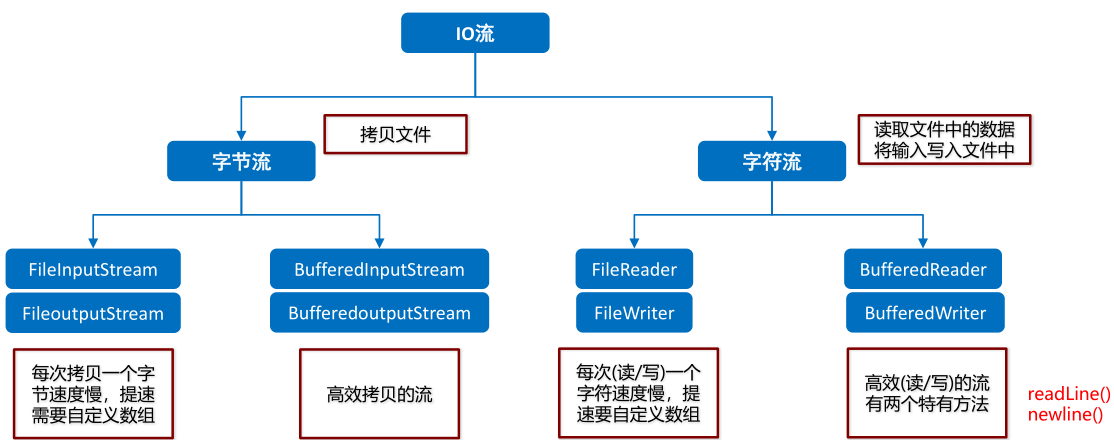
转换流
字符流中和编码解码问题相关的两个类【理解】

-
InputStreamReader:是从字节流到字符流的桥梁,父类是Reader
它读取字节,并使用指定的编码将其解码为字符
它使用的字符集可以由名称指定,也可以被明确指定,或者可以接受平台的默认字符集
-
OutputStreamWriter:是从字符流到字节流的桥梁,父类是Writer
是从字符流到字节流的桥梁,使用指定的编码将写入的字符编码为字节
它使用的字符集可以由名称指定,也可以被明确指定,或者可以接受平台的默认字符集
转换流读写数据【应用】
-
构造方法
方法名 说明 InputStreamReader(InputStream in) 使用默认字符编码创建InputStreamReader对象 InputStreamReader(InputStream in,String chatset) 使用指定的字符编码创建InputStreamReader对象 OutputStreamWriter(OutputStream out) 使用默认字符编码创建OutputStreamWriter对象 OutputStreamWriter(OutputStream out,String charset) 使用指定的字符编码创建OutputStreamWriter对象 -
代码演示
public class ConversionStreamDemo {
public static void main(String[] args) throws IOException {
//OutputStreamWriter osw = new OutputStreamWriter(new FileOutputStream("myCharStream\\osw.txt"));
OutputStreamWriter osw = new OutputStreamWriter(new FileOutputStream("myCharStream\\osw.txt"),"GBK");
osw.write("中国");
osw.close();
//InputStreamReader isr = new InputStreamReader(new FileInputStream("myCharStream\\osw.txt"));
InputStreamReader isr = new InputStreamReader(new FileInputStream("myCharStream\\osw.txt"),"GBK");
//一次读取一个字符数据
int ch;
while ((ch=isr.read())!=-1) {
System.out.print((char)ch);
}
isr.close();
}
}
- 在jdk11以后可以不使用转换流,直接使用FileReader或者FileWriter,传入Charset

- 代码实例
FileReader fr = new FileReader("D:\\file\\a.txt",Charset.forName("gbk"));
对象操作流
- 对象操作流介绍
- 如果把一个对象的数据以流的方式存储在硬盘某个文件里,那么任何人都可以查看该文件中对象的相关信息,如果该对象包含账号密码等信息则会被暴露的体无完肤。而对象流是把对象以字节的形式写到本地文件,直接打开文件,是读不懂的,需要再次使用对象操作流读到内存中去。保证了安全性。
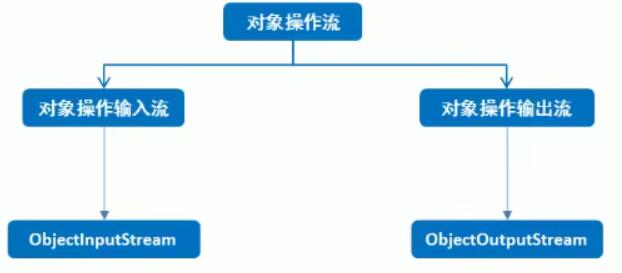
对象序列化流【应用】
-
对象序列化介绍
- 对象序列化:就是将对象保存到磁盘中,或者在网络中传输对象
- 这种机制就是使用一个字节序列表示一个对象,该字节序列包含:对象的类型、对象的数据和对象中存储的属性等信息
- 字节序列写到文件之后,相当于文件中持久保存了一个对象的信息
- 反之,该字节序列还可以从文件中读取回来,重构对象,对它进行反序列化
-
对象序列化流: ObjectOutputStream
- 将Java对象的原始数据类型和图形写入OutputStream。 可以使用ObjectInputStream读取(重构)对象。 可以通过使用流的文件来实现对象的持久存储。 如果流是网络套接字流,则可以在另一个主机上或另一个进程中重构对象
-
构造方法
方法名 说明 ObjectOutputStream(OutputStream out) 创建一个写入指定的OutputStream的ObjectOutputStream -
序列化对象的方法
方法名 说明 void writeObject(Object obj) 将指定的对象写入ObjectOutputStream -
示例代码
学生类
//如果想要这个类的对象能被序列化,那么这个类必须要实现一个接口.Serializable
//Serializable 接口的意义
//称之为是一个标记性接口,里面没有任何的抽象方法
//只要一个类实现了这个Serializable接口,那么就表示这个类的对象可以被序列化.
public class Student implements Serializable {
private String name;
private int age;
public Student() {
}
public Student(String name, int age) {
this.name = name;
this.age = age;
}
public String getName() {
return name;
}
public void setName(String name) {
this.name = name;
}
public int getAge() {
return age;
}
public void setAge(int age) {
this.age = age;
}
@Override
public String toString() {
return "Student{" +
"name='" + name + '\'' +
", age=" + age +
'}';
}
}
测试类
public class ObjectOutputStreamDemo {
public static void main(String[] args) throws IOException {
//ObjectOutputStream(OutputStream out):创建一个写入指定的OutputStream的ObjectOutputStream
ObjectOutputStream oos = new ObjectOutputStream(new FileOutputStream("myOtherStream\\oos.txt"));
//创建对象
Student s = new Student("佟丽娅",30);
//void writeObject(Object obj):将指定的对象写入ObjectOutputStream
oos.writeObject(s);
//释放资源
oos.close();
}
}
-
注意事项
- 一个对象要想被序列化,该对象所属的类必须必须实现Serializable 接口
- Serializable是一个标记接口,实现该接口,不需要重写任何方法
对象反序列化流【应用】
-
对象反序列化流: ObjectInputStream
- ObjectInputStream反序列化先前使用ObjectOutputStream编写的原始数据和对象
-
构造方法
方法名 说明 ObjectInputStream(InputStream in) 创建从指定的InputStream读取的ObjectInputStream -
反序列化对象的方法
方法名 说明 Object readObject() 从ObjectInputStream读取一个对象 -
示例代码
public class ObjectInputStreamDemo {
public static void main(String[] args) throws IOException, ClassNotFoundException {
//ObjectInputStream(InputStream in):创建从指定的InputStream读取的ObjectInputStream
ObjectInputStream ois = new ObjectInputStream(new FileInputStream("myOtherStream\\oos.txt"));
//Object readObject():从ObjectInputStream读取一个对象
Object obj = ois.readObject();
Student s = (Student) obj;
System.out.println(s.getName() + "," + s.getAge());
ois.close();
}
}
serialVersionUID&transient【应用】
-
serialVersionUID
- 用对象序列化流序列化了一个对象后,假如我们修改了对象所属的类文件,读取数据会不会出问题呢?
- 会出问题,会抛出InvalidClassException异常
- 如果出问题了,如何解决呢?
- 重新序列化
- 给对象所属的类加一个serialVersionUID
- private static final long serialVersionUID = 42L;
- 用对象序列化流序列化了一个对象后,假如我们修改了对象所属的类文件,读取数据会不会出问题呢?
-
transient
- 如果一个对象中的某个成员变量的值不想被序列化,又该如何实现呢?
- 给该成员变量加transient关键字修饰,该关键字标记的成员变量不参与序列化过程
- 如果一个对象中的某个成员变量的值不想被序列化,又该如何实现呢?
-
示例代码
学生类
public class Student implements Serializable {
//serialVersionUID 序列号
//如果我们自己没有定义,那么虚拟机会根据类中的信息会自动的计算出一个序列号.
//问题:如果我们修改了类中的信息.那么虚拟机会再次计算出一个序列号.
//第一步:把User对象序列化到本地. --- -5824992206458892149
//第二步:修改了javabean类. 导致 --- 类中的序列号 4900133124572371851
//第三步:把文件中的对象读到内存. 本地中的序列号和类中的序列号不一致了.
//解决?
//不让虚拟机帮我们自动计算,我们自己手动给出.而且这个值不要变.
private static final long serialVersionUID = 42L;
private String name;
// private int age;
private transient int age;
public Student() {
}
public Student(String name, int age) {
this.name = name;
this.age = age;
}
public String getName() {
return name;
}
public void setName(String name) {
this.name = name;
}
public int getAge() {
return age;
}
public void setAge(int age) {
this.age = age;
}
// @Override
// public String toString() {
// return "Student{" +
// "name='" + name + '\'' +
// ", age=" + age +
// '}';
// }
}
测试类
public class ObjectStreamDemo {
public static void main(String[] args) throws IOException, ClassNotFoundException {
// write();
read();
}
//反序列化
private static void read() throws IOException, ClassNotFoundException {
ObjectInputStream ois = new ObjectInputStream(new FileInputStream("myOtherStream\\oos.txt"));
Object obj = ois.readObject();
Student s = (Student) obj;
System.out.println(s.getName() + "," + s.getAge());
ois.close();
}
//序列化
private static void write() throws IOException {
ObjectOutputStream oos = new ObjectOutputStream(new FileOutputStream("myOtherStream\\oos.txt"));
Student s = new Student("佟丽娅", 30);
oos.writeObject(s);
oos.close();
}
}
对象操作流练习【应用】
-
案例需求
创建多个学生类对象写到文件中,再次读取到内存中
-
实现步骤
- 创建序列化流对象
- 创建多个学生对象
- 将学生对象添加到集合中
- 将集合对象序列化到文件中
- 创建反序列化流对象
- 将文件中的对象数据,读取到内存中
-
代码实现
学生类
public class Student implements Serializable{
private static final long serialVersionUID = 2L;
private String name;
private int age;
public Student() {
}
public Student(String name, int age) {
this.name = name;
this.age = age;
}
public String getName() {
return name;
}
public void setName(String name) {
this.name = name;
}
public int getAge() {
return age;
}
public void setAge(int age) {
this.age = age;
}
}
测试类
- 第一种方法(死循环)
public static void main(String[] args) throws Exception {
ObjectOutputStream oos = new ObjectOutputStream(new FileOutputStream("g.txt"));
Person p1 = new Person("zhangsan",12);
Person p2 = new Person("lisi",14);
Person p3 = new Person("wangwu",13);
oos.writeObject(p1);
oos.writeObject(p2);
oos.writeObject(p3);
oos.close();
ObjectInputStream ois = new ObjectInputStream(new FileInputStream("g.txt"));
while (true){
try {
Person p = (Person)ois.readObject();
System.out.println(p);
} catch (Exception e) {
break;
}
}
}
- 第二种方法(对象放入集合)
public class Demo03 {
/**
* read():
* 读取到文件末尾返回值是 -1
* readLine():
* 读取到文件的末尾返回值 null
* readObject():
* 读取到文件的末尾 直接抛出异常
* 如果要序列化的对象有多个,不建议直接将多个对象序列化到文件中,因为反序列化时容易出异常
* 建议: 将要序列化的多个对象存储到集合中,然后将集合序列化到文件中
*/
public static void main(String[] args) throws Exception {
/*// 序列化
//1.创建序列化流对象
ObjectOutputStream oos = new ObjectOutputStream(new FileOutputStream("myCode\\oos.txt"));
ArrayList<Student> arrayList = new ArrayList<>();
//2.创建多个学生对象
Student s = new Student("佟丽娅",30);
Student s01 = new Student("佟丽娅",30);
//3.将学生对象添加到集合中
arrayList.add(s);
arrayList.add(s01);
//4.将集合对象序列化到文件中
oos.writeObject(arrayList);
oos.close();*/
// 反序列化
//5.创建反序列化流对象
ObjectInputStream ois = new ObjectInputStream(new FileInputStream("myCode\\oos.txt"));
//6.将文件中的对象数据,读取到内存中
Object obj = ois.readObject();
ArrayList<Student> arrayList = (ArrayList<Student>)obj;
ois.close();
for (Student s : arrayList) {
System.out.println(s.getName() + "," + s.getAge());
}
}
}
Properties集合
Properties作为Map集合的使用【应用】
-
Properties介绍
- 是一个Map体系的集合类
- Properties可以保存到流中或从流中加载
- 属性列表中的每个键及其对应的值都是一个字符串
-
Properties基本使用
public class PropertiesDemo01 {
public static void main(String[] args) {
//创建集合对象
// Properties<String,String> prop = new Properties<String,String>(); //错误
Properties prop = new Properties();
//增
prop.put("itcast001", "佟丽娅");
prop.put("itcast002", "赵丽颖");
prop.put("itcast003", "刘诗诗");
//删
prop.remove("itcast001");
//改: put 如果键不存在就添加,如果存在就覆盖原值
prop.put("itcast002","赵本山");
//查
Object value = prop.get("itcast003");
//遍历集合
Set<Object> keySet = prop.keySet();
for (Object key : keySet) {
Object value = prop.get(key);
System.out.println(key + "," + value);
}
}
}
Properties作为Map集合的特有方法【应用】
-
特有方法
方法名 说明 Object setProperty(String key, String value) 设置集合的键和值,都是String类型,底层调用 Hashtable方法 put String getProperty(String key) 使用此属性列表中指定的键搜索属性 Set stringPropertyNames() 从该属性列表中返回一个不可修改的键集,其中键及其对应的值是字符串 -
示例代码
public class PropertiesDemo02 {
public static void main(String[] args) {
//创建集合对象
Properties prop = new Properties();
//Object setProperty(String key, String value):设置集合的键和值,都是String类型
prop.setProperty("itcast001", "佟丽娅");
prop.setProperty("itcast002", "赵丽颖");
prop.setProperty("itcast003", "刘诗诗");
//String getProperty(String key):使用此属性列表中指定的键搜索属性
// System.out.println(prop.getProperty("itcast001"));
// System.out.println(prop.getProperty("itcast0011"));
// System.out.println(prop);
//Set<String> stringPropertyNames():从该属性列表中返回一个不可修改的键集,其中键及其对应的值是字符串
Set<String> names = prop.stringPropertyNames();
for (String key : names) {
// System.out.println(key);
String value = prop.getProperty(key);
System.out.println(key + "," + value);
}
}
}
Properties和IO流相结合的方法【应用】
-
和IO流结合的方法
方法名 说明 void load(Reader reader) 从输入字符流读取属性列表(键和元素对) void store(Writer writer, String comments) 将此属性列表(键和元素对)写入此 Properties表中,以适合使用 load(Reader)方法的格式写入输出字符流,comments就是注释信息 -
示例代码
public class PropertiesDemo03 {
public static void main(String[] args) throws IOException {
//把集合中的数据保存到文件
// myStore();
//把文件中的数据加载到集合
myLoad();
}
private static void myLoad() throws IOException {
Properties prop = new Properties();
//void load(Reader reader):
FileReader fr = new FileReader("myOtherStream\\fw.txt");
prop.load(fr);
fr.close();
System.out.println(prop);
}
private static void myStore() throws IOException {
Properties prop = new Properties();
prop.setProperty("itcast001","佟丽娅");
prop.setProperty("itcast002","赵丽颖");
prop.setProperty("itcast003","刘诗诗");
//void store(Writer writer, String comments):
FileWriter fw = new FileWriter("myOtherStream\\fw.txt");
prop.store(fw,null);
fw.close();
}
}
Properties集合练习【应用】
-
案例需求
在Properties文件中手动写上姓名和年龄,读取到集合中,将该数据封装成学生对象,写到本地文件
-
实现步骤
- 创建Properties集合,将本地文件中的数据加载到集合中
- 获取集合中的键值对数据,封装到学生对象中
- 创建序列化流对象,将学生对象序列化到本地文件中
-
代码实现
学生类
public class Student implements Serializable {
private static final long serialVersionUID = 1L;
private String name;
private int age;
public Student() {
}
public Student(String name, int age) {
this.name = name;
this.age = age;
}
public String getName() {
return name;
}
public void setName(String name) {
this.name = name;
}
public int getAge() {
return age;
}
public void setAge(int age) {
this.age = age;
}
@Override
public String toString() {
return "Student{" +
"name='" + name + '\'' +
", age=" + age +
'}';
}
}
测试类
public class Test {
public static void main(String[] args) throws IOException {
//1.创建Properties集合,将本地文件中的数据加载到集合中
Properties prop = new Properties();
FileReader fr = new FileReader("prop.properties");
prop.load(fr);
fr.close();
//2.获取集合中的键值对数据,封装到学生对象中
String name = prop.getProperty("name");
int age = Integer.parseInt(prop.getProperty("age"));
Student s = new Student(name,age);
//3.创建序列化流对象,将学生对象序列化到本地文件中
ObjectOutputStream oos = new ObjectOutputStream(new FileOutputStream("a.txt"));
oos.writeObject(s);
oos.close();
}
}
打印流
PrintStream 字节打印流
-
构造方法
方法名 说明 PrintStream(File file) 创建具有指定文件且不带自动行刷新的新打印流。 PrintStream(File file, String csn) 创建具有指定文件名称和字符集且不带自动行刷新的新打印流。 PrintStream(OutputStream out) 创建新的打印流。 PrintStream(OutputStream out, boolean autoFlush) 创建新的打印流。 PrintStream(OutputStream out, boolean autoFlush, String encoding) 创建新的打印流。 PrintStream(String fileName) 创建具有指定文件名称且不带自动行刷新的新打印流。 PrintStream(String fileName, String csn) 创建具有指定文件名称和字符集且不带自动行刷新的新打印流。 -
常用方法
方法名 说明 append 将指定字符添加到此输出流。可链式追加 print 打印,默认打印到控制台,可改变打印方向
PrintWriter 字符打印流
- 用法与PrintStream完全类似,不再赘述,可自己查阅文档。
案例:日志工具类
在日志工具类中利用打印流实现每次调用,都把调用的时间以及信息打印到日志文件log.txt中。
如果log.txt不存在的话,先创建log.txt文件
Logger工具类
public class Logger {
public static void log(String msg) throws IOException {
File file = new File("log.txt");
if(!file.exists()){
file.createNewFile();
}
PrintStream printStream = new PrintStream(new FileOutputStream(file,true));
Date date = new Date();
SimpleDateFormat simpleDateFormat = new SimpleDateFormat("yyyy-dd-MM HH:mm:ss");
String s = simpleDateFormat.format(date); //日期格式化
System.setOut(printStream); //输出重定向
System.out.println(s+": "+msg);
}
}
测试类
public static void main(String[] args) throws Exception {
Logger.log("调用了System类的gc()方法,建议启动垃圾回收");
Logger.log("调用了UserService的doSome()方法");
Logger.log("用户尝试进行登录,验证失败");
Logger.log("我非常喜欢这个记录日志的工具哦!");
}
本文作者:gonghr
本文链接:https://www.cnblogs.com/gonghr/p/15001250.html
版权声明:本作品采用知识共享署名-非商业性使用-禁止演绎 2.5 中国大陆许可协议进行许可。

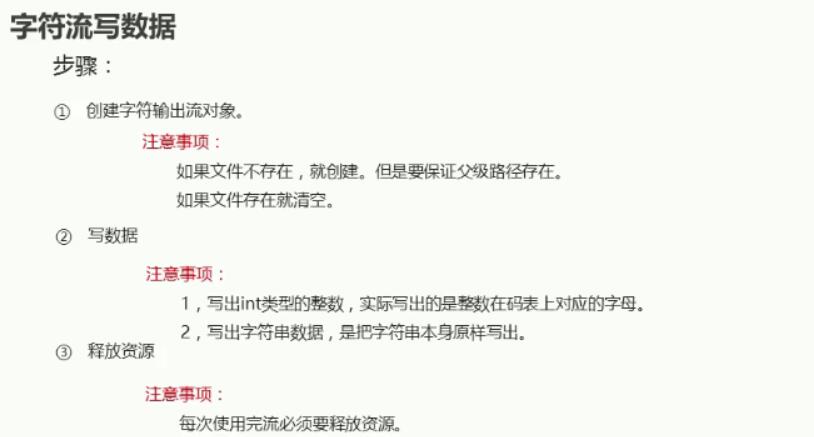



【推荐】编程新体验,更懂你的AI,立即体验豆包MarsCode编程助手
【推荐】凌霞软件回馈社区,博客园 & 1Panel & Halo 联合会员上线
【推荐】抖音旗下AI助手豆包,你的智能百科全书,全免费不限次数
【推荐】博客园社区专享云产品让利特惠,阿里云新客6.5折上折
【推荐】轻量又高性能的 SSH 工具 IShell:AI 加持,快人一步